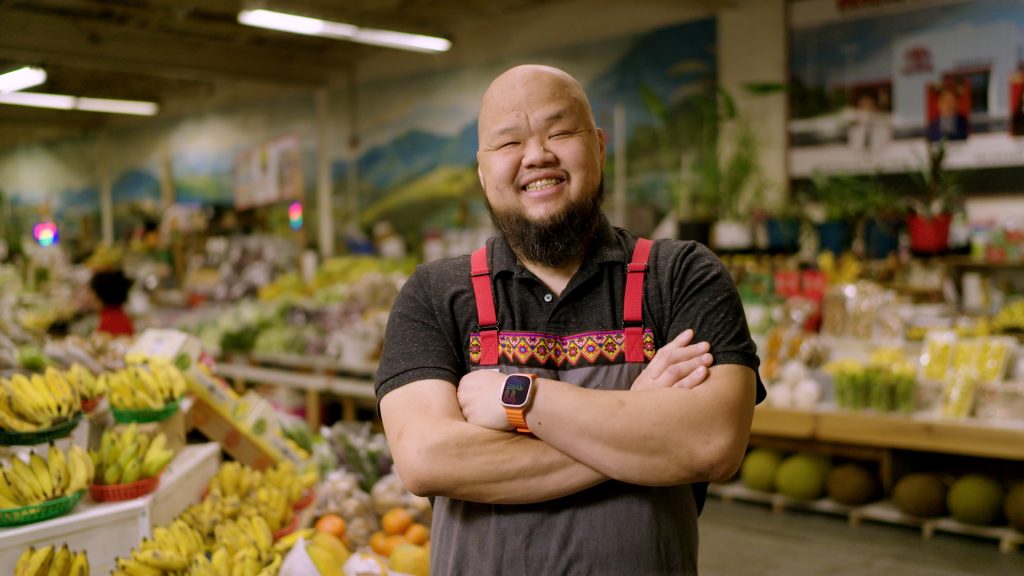
The Twin Cities PBS original series Relish returns with a bold new take and a longer format that features more local chefs, more music and more flavor. Hosted by contagiously enthusiastic Chef Yia Vang of Union Hmong Kitchen and Vinai (opening later this spring), Relish delves into the rich tapestry of food traditions, history, cultural influences, and modern expressions of taste and flavor, catering to the epicurious and those eager to explore new culinary horizons in Minnesota. Starting May 10, all six new episodes will be available to stream for free on the PBS App ahead of the broadcast premiere later this fall.
Apart from transforming Hmong classic dishes into modern marvels, Chef Vang believes that food is rooted in the power of narrative, making him the perfect host to draw out the intimate stories that connect other local chefs’ cuisine to their cultural roots. This season, we venture with him as he explores the veritable globe of the Minnesota food scene, and meets luminaries such as Sean Sherman of Owamni, John Ng of Zen Box Izakaya, Milissa Silva of El Burrito Mercado, and Aubry and Kale Walch of The Herbivorous Butcher, among many others.
We caught up with Chef Vang to get the inside scoop on his experiences hosting this new expression on Relish.
Relish is back! How do you describe this show to people?
Yia Vang: Relish to me is the digging in of stories that start from food. As humans, we search for restoration and to be restored, and that’s Relish. It’s a sense of belonging; all of us asking the question, “Where and how do I belong?” This season, we’re spending more time in each episode digging deeper into the relationships and the stories.
What was your favorite part of making these new episodes?
Yia: During interviewing, cooking, and understanding the food and the stories behind it, I have these light-bulb moments of connection. When we were at Olsen’s Fish Co., learning about lutefisk and talking about Norway, our photographer, who is from Nigeria, starts talking about the dried cod fish he ate during childhood. The Olsens said they get a lot of it and that West African folks request it. It was this moment of connection, where lutefisk is a global thing.
Olsen Fish Co. also sells the often-contentious fish made into lutefisk. What surprised you about lutefisk?
Yia: What I learned is, if you talk to a Norwegian, they will turn their nose at lutefisk and say, “Why are you eating that?” For them, it was a symbol of the old days. This also happens with some Hmong dishes. I firmly believe that, as humans, we were created for community, like our soul desires it. I think for young people who are like, “Lutefisk! No!,” you’ve got to get over it and see what’s deeper. That’s your curiosity. What I loved in that lutefisk episode is, once a year, this community comes out and gets to be around each other. It’s a sense of belonging.
In one new episode, you visit Kramarczuk’s Sausage in Northeast Minneapolis. What was special about meeting this team and learning their story?
Yia: I never thought in my lifetime I could show my dad that what he used to do in the mountains of Laos is similar to another refugee family we’ve teamed up with for Relish [the Kramarczuks are from Ukraine]. My dad shared later that, while in the refugee camp in Vietnam, he worked in the butcher section. I had never understood why I was so drawn to butchery as a kid growing up. So, it comes full circle where I’m discovering stuff about my own family.
Did you have any new food items or dishes that surprised you?
Yia: Working with Kale and Aubry Walsh from The Herbivorous Butcher [a vegan butcher], I learned a lot about Guam and the flavors they grew up with. We now use some of these flavors at Union Hmong Kitchen in a delicious mushroom broth and omelet.
Why is Relish a meaningful show for you to be part of?
Yia: It’s so important for kids watching Relish that they see people who look like them. Growing up, I never saw anybody that looked like me on TV. One of the biggest compliments I received was from a young mom who said to me, “Hey, this is my son Max, a Hmong kid. He’s 7 and he loves to cook, and he watches all your shows.” The mom then whispers in my ear, “It’s so good for my son to see someone that looks like him that’s doing this.”
What are the similarities between being a chef and being a show host?
Yia: Working in restaurants, especially cooking, you need to depend on and trust each other, and be three steps ahead. The moment you want to be a hero and be a lone wolf, you will fail, and the system will crash. Being a host, you must build trust with people you’re interviewing because you’re going into their lives. The way that a host overlaps with being a chef is saying, “Hey, I’ve got to be two steps ahead, three steps ahead, and I’ve got to be very curious.” Andrew Zimmern told me, “You are the avatar, and the viewers are going to see through your eyes.”
© Twin Cities Public Television - 2024. All rights reserved.
Read Next



